Zichuan Liu
Sample-efficient LLM Optimization with Reset Replay
Aug 08, 2025
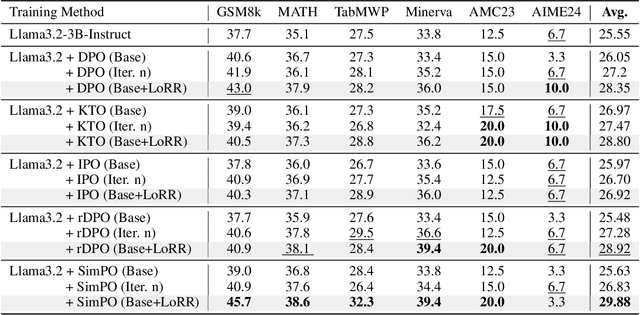
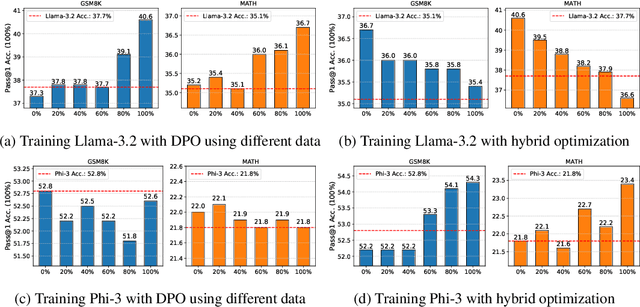
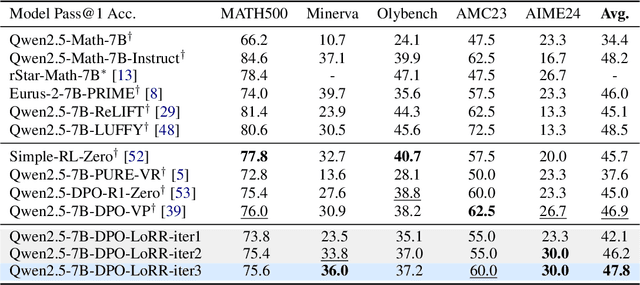
Abstract:Recent advancements in post-training Large Language Models (LLMs), particularly through Reinforcement Learning (RL) and preference optimization methods, are key drivers for enhancing their reasoning capabilities. However, these methods are often plagued by low sample efficiency and a susceptibility to primacy bias, where overfitting to initial experiences degrades policy quality and damages the learning process. To address these challenges, we introduce LLM optimization with Reset Replay (LoRR), a general and powerful plugin designed to enhance sample efficiency in any preference-based optimization framework. LoRR core mechanism enables training at a high replay number, maximizing the utility of each collected data batch. To counteract the risk of overfitting inherent in high-replay training, LoRR incorporates a periodic reset strategy with reusing initial data, which preserves network plasticity. Furthermore, it leverages a hybrid optimization objective, combining supervised fine-tuning (SFT) and preference-based losses to further bolster data exploitation. Our extensive experiments demonstrate that LoRR significantly boosts the performance of various preference optimization methods on both mathematical and general reasoning benchmarks. Notably, an iterative DPO approach augmented with LoRR achieves comparable performance on challenging math tasks, outperforming some complex and computationally intensive RL-based algorithms. These findings highlight that LoRR offers a practical, sample-efficient, and highly effective paradigm for LLM finetuning, unlocking greater performance from limited data.
Learning Joint ID-Textual Representation for ID-Preserving Image Synthesis
Apr 19, 2025Abstract:We propose a novel framework for ID-preserving generation using a multi-modal encoding strategy rather than injecting identity features via adapters into pre-trained models. Our method treats identity and text as a unified conditioning input. To achieve this, we introduce FaceCLIP, a multi-modal encoder that learns a joint embedding space for both identity and textual semantics. Given a reference face and a text prompt, FaceCLIP produces a unified representation that encodes both identity and text, which conditions a base diffusion model to generate images that are identity-consistent and text-aligned. We also present a multi-modal alignment algorithm to train FaceCLIP, using a loss that aligns its joint representation with face, text, and image embedding spaces. We then build FaceCLIP-SDXL, an ID-preserving image synthesis pipeline by integrating FaceCLIP with Stable Diffusion XL (SDXL). Compared to prior methods, FaceCLIP-SDXL enables photorealistic portrait generation with better identity preservation and textual relevance. Extensive experiments demonstrate its quantitative and qualitative superiority.
Flux Already Knows - Activating Subject-Driven Image Generation without Training
Apr 12, 2025Abstract:We propose a simple yet effective zero-shot framework for subject-driven image generation using a vanilla Flux model. By framing the task as grid-based image completion and simply replicating the subject image(s) in a mosaic layout, we activate strong identity-preserving capabilities without any additional data, training, or inference-time fine-tuning. This "free lunch" approach is further strengthened by a novel cascade attention design and meta prompting technique, boosting fidelity and versatility. Experimental results show that our method outperforms baselines across multiple key metrics in benchmarks and human preference studies, with trade-offs in certain aspects. Additionally, it supports diverse edits, including logo insertion, virtual try-on, and subject replacement or insertion. These results demonstrate that a pre-trained foundational text-to-image model can enable high-quality, resource-efficient subject-driven generation, opening new possibilities for lightweight customization in downstream applications.
InfiniteYou: Flexible Photo Recrafting While Preserving Your Identity
Mar 20, 2025Abstract:Achieving flexible and high-fidelity identity-preserved image generation remains formidable, particularly with advanced Diffusion Transformers (DiTs) like FLUX. We introduce InfiniteYou (InfU), one of the earliest robust frameworks leveraging DiTs for this task. InfU addresses significant issues of existing methods, such as insufficient identity similarity, poor text-image alignment, and low generation quality and aesthetics. Central to InfU is InfuseNet, a component that injects identity features into the DiT base model via residual connections, enhancing identity similarity while maintaining generation capabilities. A multi-stage training strategy, including pretraining and supervised fine-tuning (SFT) with synthetic single-person-multiple-sample (SPMS) data, further improves text-image alignment, ameliorates image quality, and alleviates face copy-pasting. Extensive experiments demonstrate that InfU achieves state-of-the-art performance, surpassing existing baselines. In addition, the plug-and-play design of InfU ensures compatibility with various existing methods, offering a valuable contribution to the broader community.
Humanizing the Machine: Proxy Attacks to Mislead LLM Detectors
Oct 25, 2024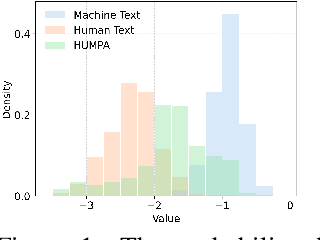
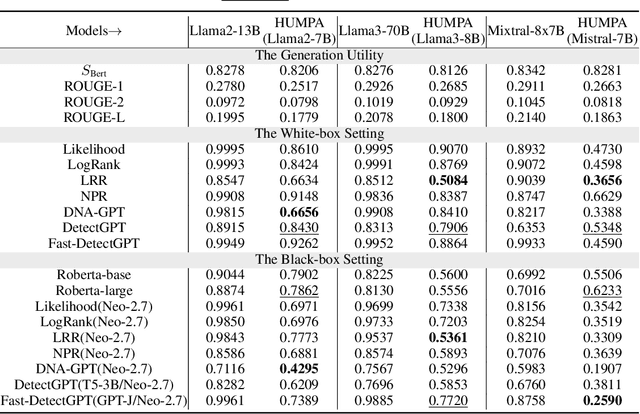
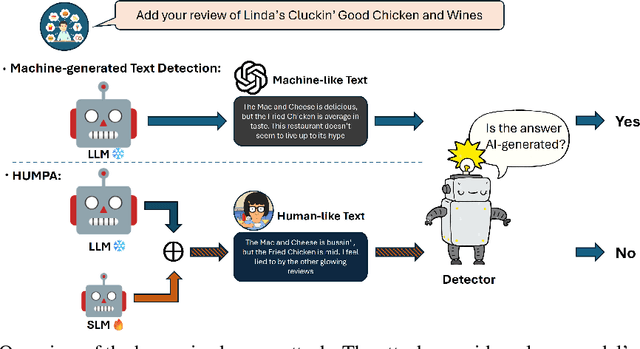
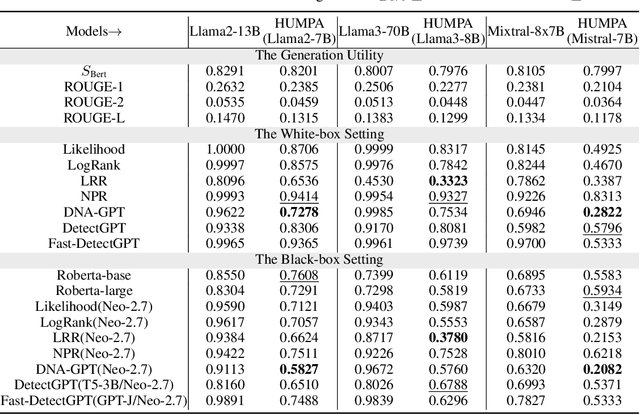
Abstract:The advent of large language models (LLMs) has revolutionized the field of text generation, producing outputs that closely mimic human-like writing. Although academic and industrial institutions have developed detectors to prevent the malicious usage of LLM-generated texts, other research has doubt about the robustness of these systems. To stress test these detectors, we introduce a proxy-attack strategy that effortlessly compromises LLMs, causing them to produce outputs that align with human-written text and mislead detection systems. Our method attacks the source model by leveraging a reinforcement learning (RL) fine-tuned humanized small language model (SLM) in the decoding phase. Through an in-depth analysis, we demonstrate that our attack strategy is capable of generating responses that are indistinguishable to detectors, preventing them from differentiating between machine-generated and human-written text. We conduct systematic evaluations on extensive datasets using proxy-attacked open-source models, including Llama2-13B, Llama3-70B, and Mixtral-8*7B in both white- and black-box settings. Our findings show that the proxy-attack strategy effectively deceives the leading detectors, resulting in an average AUROC drop of 70.4% across multiple datasets, with a maximum drop of 90.3% on a single dataset. Furthermore, in cross-discipline scenarios, our strategy also bypasses these detectors, leading to a significant relative decrease of up to 90.9%, while in cross-language scenario, the drop reaches 91.3%. Despite our proxy-attack strategy successfully bypassing the detectors with such significant relative drops, we find that the generation quality of the attacked models remains preserved, even within a modest utility budget, when compared to the text produced by the original, unattacked source model.
TraceNet: Segment one thing efficiently
Jun 21, 2024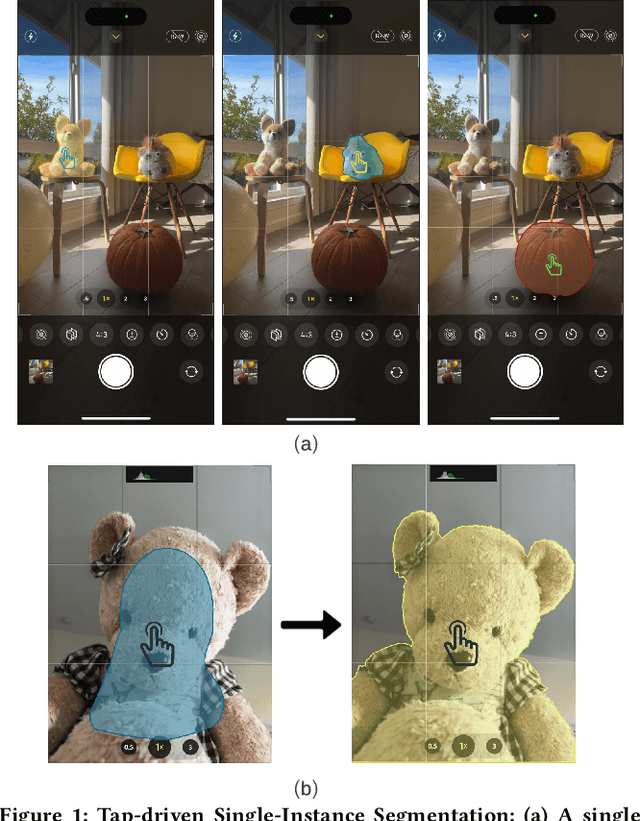
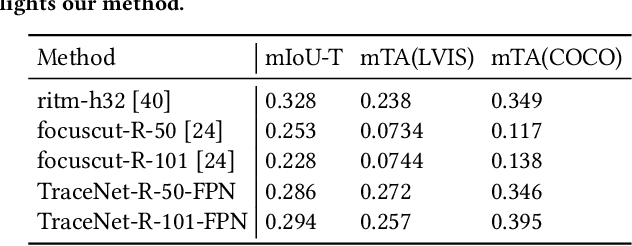
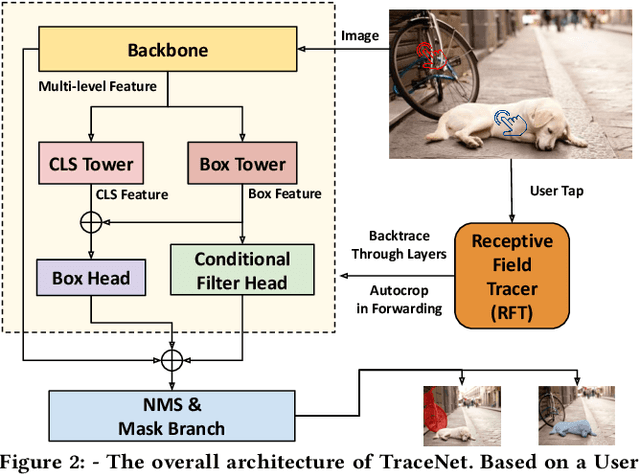

Abstract:Efficient single instance segmentation is essential for unlocking features in the mobile imaging applications, such as capture or editing. Existing on-the-fly mobile imaging applications scope the segmentation task to portraits or the salient subject due to the computational constraints. Instance segmentation, despite its recent developments towards efficient networks, is still heavy due to the cost of computation on the entire image to identify all instances. To address this, we propose and formulate a one tap driven single instance segmentation task that segments a single instance selected by a user via a positive tap. This task, in contrast to the broader task of segmenting anything as suggested in the Segment Anything Model \cite{sam}, focuses on efficient segmentation of a single instance specified by the user. To solve this problem, we present TraceNet, which explicitly locates the selected instance by way of receptive field tracing. TraceNet identifies image regions that are related to the user tap and heavy computations are only performed on selected regions of the image. Therefore overall computation cost and memory consumption are reduced during inference. We evaluate the performance of TraceNet on instance IoU average over taps and the proportion of the region that a user tap can fall into for a high-quality single-instance mask. Experimental results on MS-COCO and LVIS demonstrate the effectiveness and efficiency of the proposed approach. TraceNet can jointly achieve the efficiency and interactivity, filling in the gap between needs for efficient mobile inference and recent research trend towards multimodal and interactive segmentation models.
Position: Rethinking Post-Hoc Search-Based Neural Approaches for Solving Large-Scale Traveling Salesman Problems
Jun 02, 2024



Abstract:Recent advancements in solving large-scale traveling salesman problems (TSP) utilize the heatmap-guided Monte Carlo tree search (MCTS) paradigm, where machine learning (ML) models generate heatmaps, indicating the probability distribution of each edge being part of the optimal solution, to guide MCTS in solution finding. However, our theoretical and experimental analysis raises doubts about the effectiveness of ML-based heatmap generation. In support of this, we demonstrate that a simple baseline method can outperform complex ML approaches in heatmap generation. Furthermore, we question the practical value of the heatmap-guided MCTS paradigm. To substantiate this, our findings show its inferiority to the LKH-3 heuristic despite the paradigm's reliance on problem-specific, hand-crafted strategies. For the future, we suggest research directions focused on developing more theoretically sound heatmap generation methods and exploring autonomous, generalizable ML approaches for combinatorial problems. The code is available for review: https://github.com/xyfffff/rethink_mcts_for_tsp.
TimeX++: Learning Time-Series Explanations with Information Bottleneck
May 15, 2024Abstract:Explaining deep learning models operating on time series data is crucial in various applications of interest which require interpretable and transparent insights from time series signals. In this work, we investigate this problem from an information theoretic perspective and show that most existing measures of explainability may suffer from trivial solutions and distributional shift issues. To address these issues, we introduce a simple yet practical objective function for time series explainable learning. The design of the objective function builds upon the principle of information bottleneck (IB), and modifies the IB objective function to avoid trivial solutions and distributional shift issues. We further present TimeX++, a novel explanation framework that leverages a parametric network to produce explanation-embedded instances that are both in-distributed and label-preserving. We evaluate TimeX++ on both synthetic and real-world datasets comparing its performance against leading baselines, and validate its practical efficacy through case studies in a real-world environmental application. Quantitative and qualitative evaluations show that TimeX++ outperforms baselines across all datasets, demonstrating a substantial improvement in explanation quality for time series data. The source code is available at \url{https://github.com/zichuan-liu/TimeXplusplus}.
Protecting Your LLMs with Information Bottleneck
Apr 22, 2024Abstract:The advent of large language models (LLMs) has revolutionized the field of natural language processing, yet they might be attacked to produce harmful content. Despite efforts to ethically align LLMs, these are often fragile and can be circumvented by jailbreaking attacks through optimized or manual adversarial prompts. To address this, we introduce the Information Bottleneck Protector (IBProtector), a defense mechanism grounded in the information bottleneck principle, and we modify the objective to avoid trivial solutions. The IBProtector selectively compresses and perturbs prompts, facilitated by a lightweight and trainable extractor, preserving only essential information for the target LLMs to respond with the expected answer. Moreover, we further consider a situation where the gradient is not visible to be compatible with any LLM. Our empirical evaluations show that IBProtector outperforms current defense methods in mitigating jailbreak attempts, without overly affecting response quality or inference speed. Its effectiveness and adaptability across various attack methods and target LLMs underscore the potential of IBProtector as a novel, transferable defense that bolsters the security of LLMs without requiring modifications to the underlying models.
Higher Replay Ratio Empowers Sample-Efficient Multi-Agent Reinforcement Learning
Apr 15, 2024



Abstract:One of the notorious issues for Reinforcement Learning (RL) is poor sample efficiency. Compared to single agent RL, the sample efficiency for Multi-Agent Reinforcement Learning (MARL) is more challenging because of its inherent partial observability, non-stationary training, and enormous strategy space. Although much effort has been devoted to developing new methods and enhancing sample efficiency, we look at the widely used episodic training mechanism. In each training step, tens of frames are collected, but only one gradient step is made. We argue that this episodic training could be a source of poor sample efficiency. To better exploit the data already collected, we propose to increase the frequency of the gradient updates per environment interaction (a.k.a. Replay Ratio or Update-To-Data ratio). To show its generality, we evaluate $3$ MARL methods on $6$ SMAC tasks. The empirical results validate that a higher replay ratio significantly improves the sample efficiency for MARL algorithms. The codes to reimplement the results presented in this paper are open-sourced at https://anonymous.4open.science/r/rr_for_MARL-0D83/.
 Add to Chrome
Add to Chrome Add to Firefox
Add to Firefox Add to Edge
Add to Edge